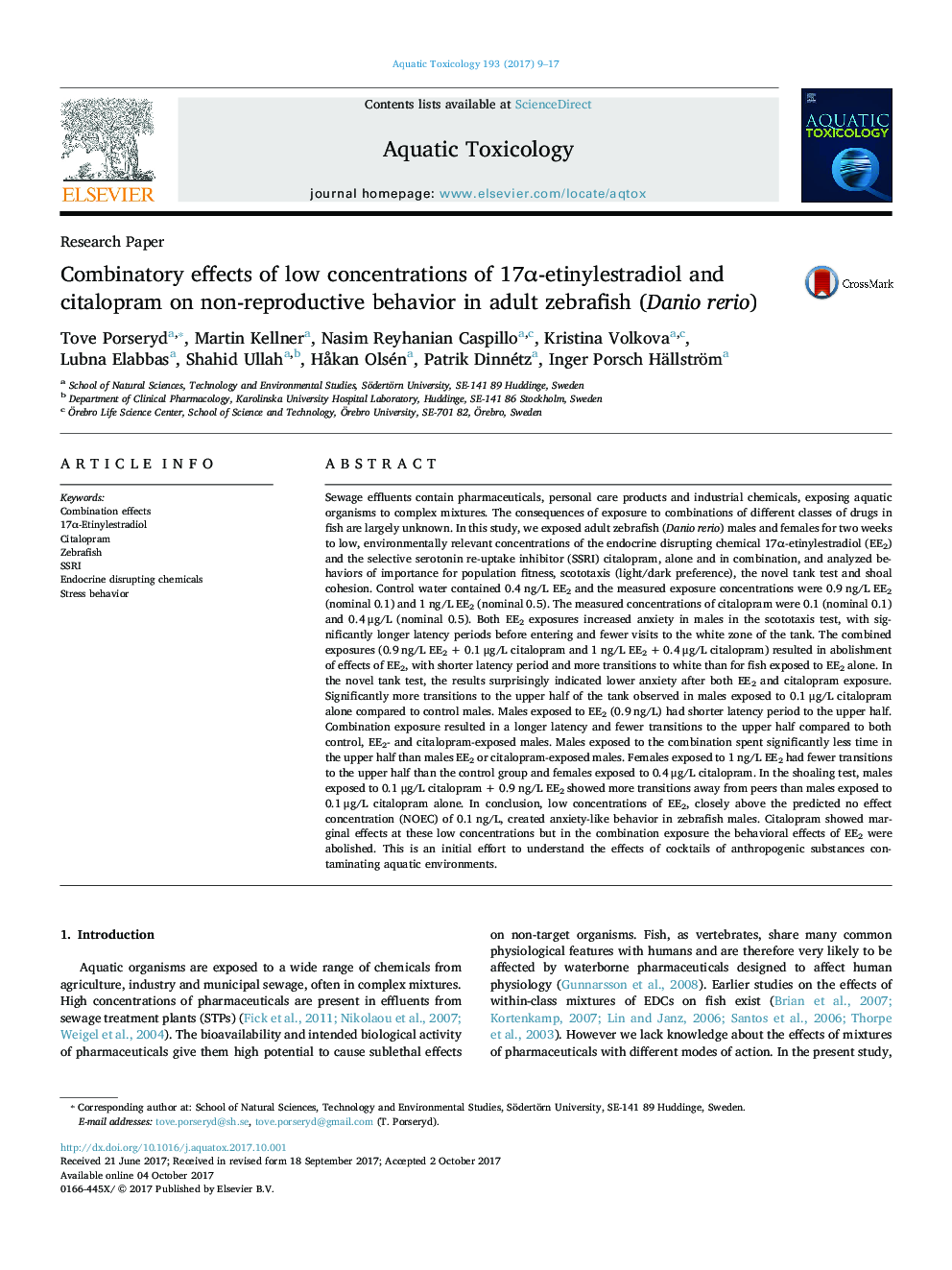| کد مقاله | کد نشریه | سال انتشار | مقاله انگلیسی | نسخه تمام متن |
|---|---|---|---|---|
| 5764082 | 1625912 | 2017 | 9 صفحه PDF | دانلود رایگان |

- Effects of low-dose EE2 and citalopram on anxiety and shoaling behavior were studied in adult zebrafish.
- Low concentrations of EE2 created anxiety-like behavior in the scototaxis test in zebrafish males but not in females.
- Citalopram showed no effects on scototaxis at these concentrations but in the combination exposure, the behavioral effects of EE2 were abolished.
- In the novel tank test decreased anxiety was observed for both substances while the combination increased anxiety.
Sewage effluents contain pharmaceuticals, personal care products and industrial chemicals, exposing aquatic organisms to complex mixtures. The consequences of exposure to combinations of different classes of drugs in fish are largely unknown. In this study, we exposed adult zebrafish (Danio rerio) males and females for two weeks to low, environmentally relevant concentrations of the endocrine disrupting chemical 17α-etinylestradiol (EE2) and the selective serotonin re-uptake inhibitor (SSRI) citalopram, alone and in combination, and analyzed behaviors of importance for population fitness, scototaxis (light/dark preference), the novel tank test and shoal cohesion. Control water contained 0.4 ng/L EE2 and the measured exposure concentrations were 0.9 ng/L EE2 (nominal 0.1) and 1 ng/L EE2 (nominal 0.5). The measured concentrations of citalopram were 0.1 (nominal 0.1) and 0.4 μg/L (nominal 0.5). Both EE2 exposures increased anxiety in males in the scototaxis test, with significantly longer latency periods before entering and fewer visits to the white zone of the tank. The combined exposures (0.9 ng/L EE2 + 0.1 μg/L citalopram and 1 ng/L EE2 + 0.4 μg/L citalopram) resulted in abolishment of effects of EE2, with shorter latency period and more transitions to white than for fish exposed to EE2 alone. In the novel tank test, the results surprisingly indicated lower anxiety after both EE2 and citalopram exposure. Significantly more transitions to the upper half of the tank observed in males exposed to 0.1 μg/L citalopram alone compared to control males. Males exposed to EE2 (0.9 ng/L) had shorter latency period to the upper half. Combination exposure resulted in a longer latency and fewer transitions to the upper half compared to both control, EE2- and citalopram-exposed males. Males exposed to the combination spent significantly less time in the upper half than males EE2 or citalopram-exposed males. Females exposed to 1 ng/L EE2 had fewer transitions to the upper half than the control group and females exposed to 0.4 μg/L citalopram. In the shoaling test, males exposed to 0.1 μg/L citalopram + 0.9 ng/L EE2 showed more transitions away from peers than males exposed to 0.1 μg/L citalopram alone. In conclusion, low concentrations of EE2, closely above the predicted no effect concentration (NOEC) of 0.1 ng/L, created anxiety-like behavior in zebrafish males. Citalopram showed marginal effects at these low concentrations but in the combination exposure the behavioral effects of EE2 were abolished. This is an initial effort to understand the effects of cocktails of anthropogenic substances contaminating aquatic environments.
Journal: Aquatic Toxicology - Volume 193, December 2017, Pages 9-17